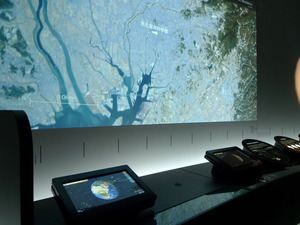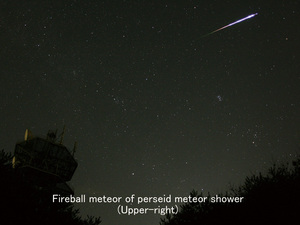Nagoya City Science Museum
TOP > Exhibition Guide > Keyword Search > Starting with "M" > magnetosphere > The Earth
The Earth



Purpose of Exhibition
The perimeter of this room displays various celestial bodies and events, arranged according to the concept of Powers of Ten, where the scale is increased by a factor of ten.
The journey to the end of the Universe begins on the Earth. Images of the earth and the moon, the magnetosphere and auroras, origins and types of meteorites, and meteors are displayed on the large screen.
Additional Knowledge
[The Real Number of Shooting Stars]
On a meteor shower night, you can expect to see more shooting stars than usual. However, it does not mean they appear one after another as you might have seen on a movie.
Two of the most impressive meteor showers in a year are the Perseids in mid-August and the Geminids in mid-December. They both annually produce rich and reliable showers.
Now, I just said “rich” above, but how do you count shooting stars? You need to make sure that the conditions are consistent from year to year in order to accumulate and compare meteor counts for decades. So, we have to make some corrections to raw data by assuming how many meteors we would have observed if we had had ideal observation conditions: clear sky, dark enough to see the Milky Way, the radiant point was situated just at the zenith (that is, meteoroids plow into the atmosphere directly overhead), and you had never missed even dark and faint shooting stars all over the sky. These are, of course, impossible, or rather, imaginary; but in order to make comparisons, we have to correct, or in short, pad the annual data up to this hypothetical situation. This ideal number of meteors is called ZHR (Zenithal Hourly Rate).
So, you can’t assume that you will see as many shooting stars as the ZHR indicates, although that is certainly an essential way to compare and study meteor showers over the years. Most of the time, you would have at least a few clouds. The sky is bright enough to obscure the Milky Way. You’re watching before or after the radiant point is at its zenith. And perhaps, you may lose count. I mean to say, you can probably see no more than half of what the ZHR predicted, even if you are out in the mountains or on the beaches which offer good views of the night sky.
The “Hourly Rate” is also tricky. Let’s say there are 60 shooting stars per hour. That is, one per minute. If you get only one every time the second hand goes around, you would never feel like they are falling one after another. In addition, one may be flying behind you, or may be very faint. Dark meteors could be seen in the mountains, but not in the city.
Although the above is disappointing, still a meteor shower will give you something wonderful. Let’s think about it a little different. The night of meteor shower offers you a great chance to meet shooting stars, rarely seen in everyday life, if not rain of stars. Some might stand out so brightly that you can easily see them in the city, not deep in the mountains. There is no doubt that the meteor shower night is the most likely time to encounter such memorable shooting stars. Why don’t you stay up late for such a special night?
This page was last edited on 19 June 2022.
Article by Astronomy Section
